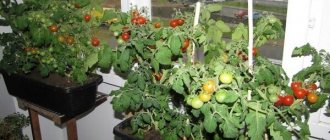Growing delicious tomatoes at home is a very exciting activity. To grow healthy bushes and get a good harvest, you need not only to follow all agricultural practices, but also to select the right varieties. Tomato Balcony Miracle is a low-growing, early-ripening variety suitable for container growing and can be used for year-round cultivation on a windowsill. Its neat, standard bushes do not require gartering or removal of stepsons. The variety allows you to get a harvest of your own grown tomatoes even in the center of Moscow.
General information about the variety
Balcony Miracle tomatoes are classified as early ripening varieties. After germination, the crop begins to bear fruit after 90-100 days.
Seeds of the variety are sold by different agricultural companies: Aelita, Gavrish, Plasmas, Sedek, Semko and Siberian Garden.
The plant is low-growing, at home it does not exceed a height of 30-40 cm. The bush does not need additional support or removal of stepsons. The tomato is ideal for growing in pots on a window in winter or on a balcony or loggia in summer.
Also, some gardeners in reviews claim that the variety feels great when grown in open ground. There it bears fruit more abundantly and forms larger fruits than at home.
Each decorative bush forms 4-5 simple brushes, on each of which 7-8 ovaries appear.
With proper agricultural technology, the yield from each bush can reach 1.5-2 kg. But gardeners most often achieve such indicators when growing crops in open ground.
Thanks to the early fruiting period, the tomato has time to escape late blight in the open ground.
The variety produces round miniature fruits that are distinguished by high taste. The first tomatoes ripen by mid-July when sown as seedlings in early April.
Tomatoes are ideal for both fresh consumption and as a canned product.
Growing tomatoes Balcony miracle
To ensure that tomatoes ripen in the spring, sow the seeds in December-January. You can immediately choose a wooden box or large pots, because the grown seedlings do not need to be planted. Many vegetable growers use cut-off 5-7 liter bottles as containers.
To grow tomatoes at home, observe the following conditions:
- Choose a large pot for the plant.
- Prepare fertile soil that is superior to garden soil.
- Provide the plant with access to light.
- Follow the feeding regime.
If all requirements are met, you can get your first harvest within 3 months.
Seed preparation
Buy seeds from trusted producers - the fruiting of the variety depends on this. Before planting, examine each grain; treat whole specimens with a pale pink solution of potassium permanganate or Fitosporin.
Alternatively, wrap the seeds in damp gauze to allow them to germinate, then plant them in the ground. You don’t have to do this, since Balcony Miracle tomatoes grow well from dry seeds, the main thing is to follow the rules of care and planting.
Planting seeds for seedlings
If the seeds are ready to plant, start preparing the soil. In 3-4 days, distribute the soil into cups or use another container, fill with warm water. Plant seeds in the following sequence:
- Make a hole in the pot to drain the water, fill it with loose and nutritious soil, and mulch.
- In a large container for future tomato seedlings, make small depressions (up to 2 cm) at a distance from each other.
- Place several seeds in each hole to a depth of 1-1.5 cm, cover with fresh soil.
- Cover the pots (containers) with polyethylene and put them in a dark, warm place for several days.
- When the first shoots appear (after about 3 days), remove the film and move the seedlings to a well-lit place.
- Water the plant regularly with warm water so that the root system strengthens and grows faster.
Seedling care
Follow these recommendations for caring for seedlings:
- Tomatoes need light. The place in which the seedlings are located should be well lit. If there are not enough natural sources, use lamps to illuminate the seedlings. In poor lighting conditions, the fruits do not ripen well and the yield decreases.
- Regular watering. Spray the seedlings with a spray bottle in the morning and evening. Maintain a humidity level of 65-70%. The plant does not tolerate drafts, so avoid their presence in the room with seedlings.
- Temperature conditions. Seedlings grow better in warm conditions. Ensure the room temperature is 19-20 degrees, avoid sudden changes. At night, store the seedlings at 16 degrees.
Soil selection
Seed growth depends on the quality of the soil. Buy a nutrient mixture for tomatoes at a specialty store or prepare it yourself. In the latter case, mix peat, humus and turf soil in equal proportions. Add 500 ml of ash and 2 matchboxes of superphosphates to 1 bucket of the resulting mixture.
The optimal soil for planting seeds is black soil with humus in equal proportions. Add superphosphates, urea or ammonium nitrate, ash or potassium supplements to the substrate for greater fruiting.
Transplanting seedlings
If the tomatoes are planted in a large container or separate pots, you should not replant them. Even in close proximity, the seedlings feel comfortable and bear fruit in a timely manner even at home.
When 3-5 leaves appear, it is allowed to replant the plant in open ground or another pot, depending on future goals. Water the soil well first so that it can easily separate from the walls of the container.
Plant the plant itself in the center of the pot, add a little fertile soil to the sides for fixation. The same manipulations are needed when planting Balcony Miracle tomatoes in open ground, while the distance between neighboring plants should be 25-30 cm. Water the seedlings immediately.
Sowing time
Balcony miracle tomatoes can be planted as seedlings when grown at home in any month. Some people plant seeds at the end of September so that they can enjoy their own tomatoes for the New Year. At the same time, it is very important to provide the seedlings with high-quality supplementary lighting.
Manufacturers recommend planting the seeds of the variety from the first to second ten days of April when growing seedlings at home or on a glazed balcony. These planting dates can also be adhered to in the case of moving seedlings to open ground.
.
Sowing too early in the absence of additional lighting can lead to stretching of seedlings.
Planting seeds and caring for seedlings
Before planting seeds for seedlings, experienced gardeners must disinfect the seed. This will increase germination and avoid further problems at the stage of growing seedlings.
To disinfect seeds, use a solution of Fitosporin, potassium permanganate, Chlorhexidine, and hydrogen peroxide. The planting material is immersed in a disinfectant liquid for half an hour, then the grains are dried and planted in the prepared substrate.
Additionally, the manufacturer recommends soaking the seed in a growth stimulator. This will speed up the process of seedling emergence and increase germination. Epin, Ecopin and other similar drugs are used as stimulants.
It is better to use specially designed seedlings for growing the Balcony Miracle variety. Such soil contains all the necessary elements for the normal development of seedlings. In addition, this reduces the risk of developing fungal diseases of tomatoes.
To be on the safe side, experienced gardeners disinfect even purchased substrate. You should not rely on the integrity of manufacturers.
Many sources recommend calcining the earth in the oven. But this is inconvenient and unhygienic. It is enough to spill the soil with the same solution of Fitosporin an hour before planting.
For planting, seedling boxes or special pallets are used. When planting in a common container, the distance between the grooves and the grains must be at least 1 cm. The seeds are planted to a depth of no more than 1 cm. If small grains are planted too deeply, there is a high probability that they will not sprout.
Sowing
After planting, the soil is generously moistened with a spray bottle, the planting containers are covered with film or glass and put away in a warm place. In an apartment, the best option for keeping seeds until germination is to place them on the floor under heating radiators.
It is important to regularly ventilate containers with seed and monitor soil moisture. For seeds, both waterlogging and overdrying of the substrate are equally dangerous.
After the first shoots begin to appear, the planting containers are exposed to light and the seedlings are kept at a temperature of +23 to +25 degrees.
Seedlings planted in April can be kept on the windowsill. When planting earlier, it is not recommended to place seedlings on a window due to low temperatures. The seedlings will develop poorly and be stunted.
When planting early, seedling containers are placed next to the window sill on a table or special racks.
Picking
After one or two true leaves appear, the Balcony Miracle variety is picked. For the procedure, peat pots or plastic cups with a volume of 200 ml are used. Be sure to make lower holes to drain excess fluid.
Instructions for picking tomatoes step by step:
- The seedlings are moistened abundantly.
- Using a wooden peg or finger, the seedling is removed from the substrate.
- A depression is made in a prepared glass filled with substrate.
- Place the seedling in the hole and lightly press the soil around it.
After planting, the seedlings are watered and removed from direct sunlight for a couple of days.
14 days after picking, the Balcony Miracle is fed with a specialized complex fertilizer for tomato seedlings.
Before planting in permanent growing containers or open ground, another picking into 0.5 liter cups may be required.
Features of care on windows and balconies
Tomatoes are transplanted into permanent pots at the age of 30-45 days.
For the normal development of Balcony Miracle bushes, containers of at least 2 liters are needed. These are the manufacturer's recommendations. But as the practice of vegetable growers shows, it is better to choose pots of at least 4 liters for the crop. Plastic 5-liter bottles with the neck cut off are also suitable for growing.
Watering
Water tomatoes on the balcony or at home not according to any specific schedule, but as the soil dries out. Here a lot depends on the substrate itself and the temperature of the content.
If there is a lack of moisture at home, the Balcony Miracle loses its decorative effect, some of the leaves die, and the yield decreases.
Excess liquid leads to soil acidification and problems with the root system. The bushes begin to hurt, and you should not expect a good harvest from such plants.
For irrigation, use settled water at room temperature. The procedure is carried out in the early morning hours or late afternoon.
After each moistening, the soil in the pots is loosened to improve aeration.
Lighting requirements
Balcony miracle, like all tomatoes, loves the sun. Windows and balconies facing the south or south-east are ideal for growing.
When kept on northern windows, seedlings become pale, develop poorly and elongate.
Feeding schedule
When grown and cared for at home, the Balcony Miracle, like other indoor tomatoes, requires frequent feeding. The smaller the volume of the pot in which the crop grows, the more often the bushes need to be fertilized.
Ideally, balcony tomatoes are fed 2 times a month. In the first month of life, seedlings need more nitrogen, which is necessary for plants to grow leaf apparatus.
After extending the second brush, apply boric acid or fertilizers intended for tomatoes during flowering and fruiting (Ovary, Bud, etc.). Such supplements contain large doses of phosphorus, calcium and potassium, which are necessary for normal fruit formation.
Fertilizing with nitrogen-containing fertilizers during this period is completely excluded. Otherwise, balcony tomatoes will actively grow greenery to the detriment of fruiting. The vegetable grower may never wait for the harvest.
Possible problems and their solutions
The stretched seedlings are buried a little deeper into the ground, so that the cotyledon leaves are above the surface of the soil. At the first sign of infection, infected bushes should be thrown away, otherwise they will infect nearby plants.
The temperature on the loggia is too low
In winter, you need to take care of additional heating; the temperature in the room where tomatoes are grown should not fall below 18 degrees.
Lack of opportunity for pollination
If a tomato is grown on a windowsill and there is no way to allow pollinating insects in, you can resort to artificial pollination with a thin brush with delicate bristles.
Late blight
The disease develops at high humidity and low temperature. Do not water the bushes from above, along the leaves, as this promotes the spread of late blight. A reliable remedy against the disease is fungicides.
Unsettled water
You cannot collect water from the tap and water it immediately. Use only warm, settled water for irrigation. Otherwise, whitish concentric spots will appear on the leaves, which over time can spread to the entire plant.
Expert opinion
Stanislav Pavlovich
Gardener with 17 years of experience and our expert
Ask a Question
Tomato seedlings Balcony miracle needs moderate watering with water at room temperature.
Too bushy plant
Form a bush, do not allow it to grow. Remove fattening shoots, shoots, cut off the lower leaves.
Stepchildren
Stepchildren can be removed no more than twice every three days. Removing fattening shoots will allow you to redirect all the energy of the bush to ripening the fruits. To protect tomato bushes from being pulled, you should lower the temperature after picking.
Planting and cultivation in open ground
Tomatoes are planted in open ground after the air warms up to +12 degrees and the likelihood of reverse frosts has passed.
On every square m. The manufacturer recommends placing no more than 5 bushes.
The agricultural technology for growing Balcony Miracle tomatoes in open ground is the same as for other early-ripening varieties.
Read more about growing tomatoes in open ground here.
The crop needs 3 feedings per season. The first of them is carried out 2-4 weeks after moving to a permanent place. The next 2 feedings are done during flowering and ovary formation.
The balcony miracle, according to the manufacturer, does not require tying up bushes or pinching in open ground. However, reviews from those who planted the variety claim that due to the abundance of fruits, the tomato stems still need to be provided with additional support.
Possible problems during cultivation
At the stage of growing seedlings, the Balcony Miracle may develop blackleg. Disinfecting the seeds and soil before planting and moderate watering without soaking the soil will help to avoid the problem.
At high temperatures in the house or on the balcony, spider mites may take a liking to seedlings. The appearance of a pest on seedlings cannot be avoided with infected indoor flowers that are placed nearby.
Placing seedlings away from home flowers and frequently spraying tomatoes with water will help reduce the likelihood of spider mite infestation.
Aphids, thrips and other insects can also move onto tender seedlings from indoor crops. Therefore, it is not recommended to keep these two varieties of culture in the same room.
With frequent fertilizing with nitrogen-containing preparations, the vegetable grower may encounter fattening of tomatoes. Avoiding nitrogen fertilizers after transplanting seedlings into permanent pots will help reduce the likelihood of problems.
Soil selection
Great importance is attached to the soil for growing “wonderful” tomatoes. They need nutritious soil with a slight acidity. The soil should not be heavy. Before planting, the soil is purchased at retail outlets for gardeners, but you can create a suitable mixture yourself:
- Mix chernozem, humus and peat soil in equal parts.
- Disinfect it by keeping it in the oven for half an hour or in the microwave for a minute.
- Fertilize with fertilizer containing superphosphate, potassium and urea components.
It’s easy to make soil for seedlings with your own hands.
When using garden soil, it is not recommended to collect it from the place where potatoes, peppers and eggplants were previously planted.
Prices for soil for plants
soil for plants
Advantages and disadvantages according to reviews from vegetable growers
Most vegetable growers who grew Balcony Miracle at home speak positively about the variety. Based on their opinions, the advantages and disadvantages of tomatoes were highlighted.
Advantages and disadvantages
Ideal for growing at home and on the balcony due to its compactness.
Early ripening and extended fruiting period.
Can be grown at any time of the year provided there is sufficient lighting.
Highly decorative in combination with abundant fruiting.
Delicious aromatic fruits with a pronounced tomato taste.
Suitable for growing for beginners.
Does not need to remove stepsons.
Despite the manufacturer’s assurances, it requires gartering in open ground.
At home, yields are significantly lower than in garden beds.
One of the disadvantages that vegetable growers call the Balcony Miracle variety is its dense skin. But this disadvantage can also be an advantage if you use tomatoes not fresh, but for canning.
Pests and diseases
Despite the high disease resistance, tomatoes of the Balcony Miracle variety can still suffer from diseases if agricultural practices are not followed.
Powdery mildew
The development of the disease begins with the lower leaves, a characteristic white coating appears on them. With further progression, the disease spreads higher. Then the areas covered with plaque turn yellow and die. The main cause of powdery mildew is high humidity and lack of ventilation. For treatment, solutions of copper-containing fungicides are used.
Blackleg
A dangerous fungal disease that affects the root collar. The main reason for its development is severe waterlogging of the soil. On affected plants, characteristic blackening is observed in the root collar area. Then a kind of constriction appears and the tomato dies. Infected plants are immediately removed, and the remaining ones are treated with a fungicide solution.
The most common pest found on indoor tomatoes.
Aphid
A small sucking pest that feeds on the sap of young leaves and shoots. The affected leaves first curl and then begin to turn yellow. To kill aphids, plants are washed with a solution of ordinary laundry soap. If the infection is widespread, insecticides are used: “Aktaru”, “Commander”, “Tanrek”.
Whitefly
A very dangerous sucking pest. In addition to tomatoes, it can also spread to other indoor plants. For destruction, systemic insecticides with a long period of action are used. 10 days after the first treatment, repeat spraying must be carried out.
According to reviews from those who grew this tomato, the variety bears fruit well even when grown on a windowsill. This allows you to enjoy fresh tomatoes even in winter.
Similar cultivars
According to the description of the variety and characteristics, the Balcony Miracle tomato is similar to some cultivars for home cultivation:
- Tomato Pinocchio is a mid-season low-growing variety up to 35 cm high. Forms round red tomatoes weighing up to 20 g.
- Bonsai is an ultra-early ripening cultivar that begins to bear fruit 85-90 days after the seedlings appear. The plant is compact, dwarf, and does not exceed 20-30 cm in height.
- Baby is a miniature tomato variety with a height of 20-30 cm. It bears fruit abundantly already 85-90 days after germination. The weight of one tomato is 15 g.
Competent dive
Adult tomato Balcony miracle
To successfully grow “balcony miracle” tomatoes, we will pay special attention to transplanting them into large pots or beds. In another way, this process is called picking. Pour expanded clay into clay or plastic pots with a volume of at least one liter to create drainage. Pebbles or small crushed stone will also work. Then add the soil composition described above and make a hole the size of a small fist. Pour a small amount of water into the hole and wait for it to be absorbed.
Carefully, pulling the bags, we take out the lumps of earth with seedlings. Carefully remove the film and immerse the lump with the root into the recess. Using light pressure, without damaging the roots, we compact the seedling and additionally irrigate it with a little moisture. Transplantation is performed in the evening, when sunlight does not burn the greens. We try to shield the “babies” from the sun’s rays with a little shading for better survival.
Attention! Successful breeding of tomatoes is achieved by the fact that when diving, the young plants must have at least 2, and preferably 3, branches with leaves well developed.











